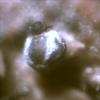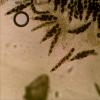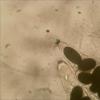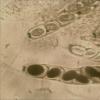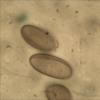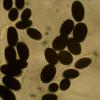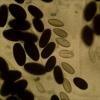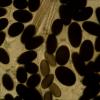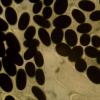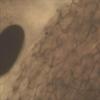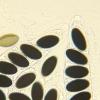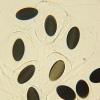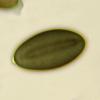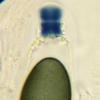
18-01-2016 00:58
 Rubén Martínez-Gil
Rubén Martínez-Gil
Hola a todos. Ayer tambié encontré estos ejempl

18-01-2016 20:34
Someone can get, the following literature:Kušan,I

22-01-2016 13:45
 Joop van der Lee
Joop van der Lee
Found on rabbit dung. Fruitbody: 248x182 um.Asci:

21-01-2016 17:38
 Blasco Rafael
Blasco Rafael
Hola, tengo esta muestra sobre musgos, me recuerda
Hypocopra
Joop van der Lee,
22-01-2016 10:33
 Found on rabbit dung.
Found on rabbit dung.This species has characteristics of Sordaria as well as Coniochaeta but up till now I do not have any clou what it might be.
Fruitbody: Spherical, with a short and broad neck, no hairs foung, body is completely submerged in the dung and only the neck is visible.
Asci: 8-spored; 256.6-274.5X25.5-28.2 um, swelling in width from 43-59 um in water. Apical apparatus showing blue with Melzer; short stalk.
Spores: Uniseriate; very dark brown when mature; mature spores 26-43x16-23 um;
immature spores 26.4-28.8x12-15.9 um; spores are surrounded by a gelatinous sheath; spores have a longitudinal germ slit along the entire length of the spore.
Enrique Rubio,
22-01-2016 10:37
Re : Unknown pyrenomycete
Why not an Hypocopra species?
Joop van der Lee,
22-01-2016 10:54

Re : Unknown pyrenomycete
Thanks for the hint Enrique.
I have also checked the endostratum and stroma cells and they do correspond with the description in Doveri FFI with Hypocopra merdaria but the length of the asci do not.
Also the great variety in spore size is not mentioned and length of germ pore is along the hole spore.
These correspond with H. festucacea.
Joop
Michel Delpont,
22-01-2016 14:31

Re : Unknown pyrenomycete
Hi Joop.
Spores of H.festucacea has two cells; on your photos we see only a single cell, in addition, the stroma is normally colored. Delicate kind,to start, you need to observe from where stroma, if tomenteux or not (as perithecia), and also see if one or more perithecia.
Bonne recherche !
Michel.
Spores of H.festucacea has two cells; on your photos we see only a single cell, in addition, the stroma is normally colored. Delicate kind,to start, you need to observe from where stroma, if tomenteux or not (as perithecia), and also see if one or more perithecia.
Bonne recherche !
Michel.
Joop van der Lee,
22-01-2016 16:02

Re : Unknown pyrenomycete
We'll do, thanks Michel
Joop
Peter Püwert,
22-01-2016 21:48
